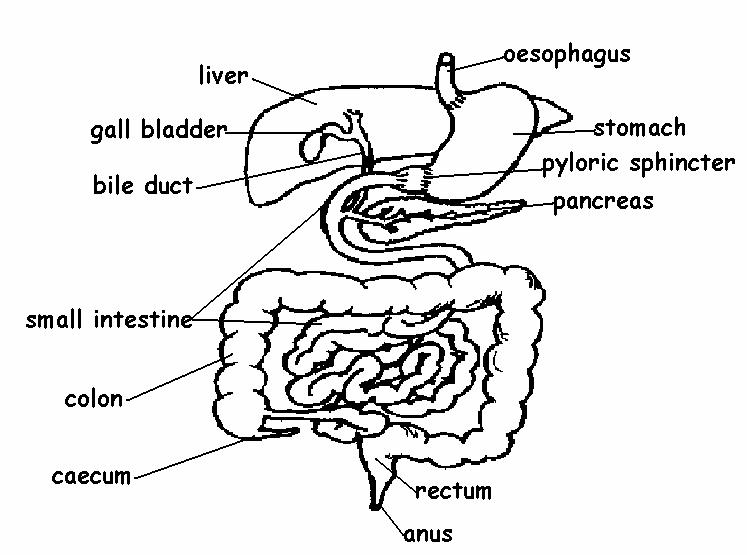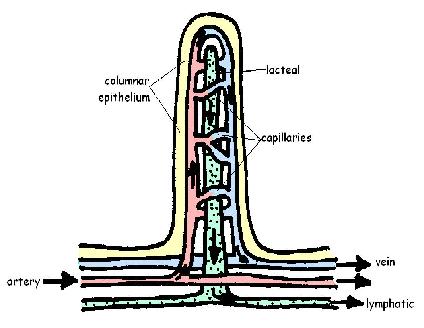The Anatomy and Physiology of Animals/Digestive System Worksheet/Worksheet Answers
1. Add the labels to the diagram of a mammal’s gut below.
2. Match the region of the digestive system in the list below with the correct function.
| Region/organ | Function |
|---|---|
| B. Pancreas | Produces the enzymes to digest proteins, fats and carbohydrates
in the small intestine. Also produces the hormone insulin |
| H. Tongue | Organ that mixes food in the mouth and makes swallowing happen |
| N. Rumen | Micro-organisms digest cellulose in this modified part of the stomach |
| L. Salivary glands | Produce saliva containing salivary amylase |
| K. Oesophagus | Carries the food from the mouth to the stomach |
| F. Gall bladder | Stores bile |
| M. Pyloric sphincter | This muscle controls the passage of food out of the stomach |
| D. Pharynx | Both food and air pass along this |
| A. Rectum | Indigestible matter held here before defecation |
| I. Liver | Produces bile |
| E. Stomach | A bag made of muscle where food is held. Gastric juice and
hydrochloric acid are added here. |
| J. Small intestine | Where food is mixed with bile and digestion of proteins, fats and
carbohydrates takes place |
| G. Colon | Water and salt are absorbed here |
| C. Functional caecum
? |
Where micro-organisms digest fibre in rabbits and horses |
3. True or False?
- a) Carnivores eat meat, herbivores eat plants and omnivores eat both. T
- b) These are all herbivores: cows, horses, goats, giraffes, rabbits and guinea pigs. T
- c) Plant material has high food value and animals need to eat only a little to get all the nutrients they need.
- F. Plants have a low food value and animals need to eat a large volume to obtain sufficient nutrients.
- d) Herbivores have well developed teeth for crushing and grinding plant cell walls. T
- e) Herbivores have glands that produce enzymes to digest plant material.
- F. No mammals produce their own enzymes to digest the cellulose cell walls of plants. Herbivores rely on microorganisms that can digest cellulose to do this for them.
- f) The rumen holds micro-organisms that digest cellulose. T
- g) Animals with a rumen also have a functional caecum to help digest cellulose.
- F. Herbivores either have a rumen or a functional caecum, not both.
- h) Carnivores need to eat most of the day to get enough nutrients.
- F. Meat has a high food value and is easily digested so carnivores can eat a quick meal and spend the rest of the day (and even the next) resting.
- i) Carnassial teeth are modified canines for shearing flesh and bone.
- F. Carnassials are modified combined premolars and molars.
- j) Open rooted teeth are found in rats and rabbits and grow throughout the animal’s life.T
- k) The numbers in a dental formula indicate the numbers of different kinds of teeth in one side only of the mouth of an animal. T
- l) Dentine is the hardest substance in a tooth.
- F. No, enamel found on the outside of the tooth is the hardest substance in the body.
4. Match the terms in the list below with the descriptions in the table
| Term | Description |
|---|---|
| Enamel | Hardest substance in the body; covers the tooth |
| Dentine | Found under the enamel of the tooth |
| Incisors | Chisel-shaped teeth at the front of the mouth |
| Dental formula | The way in which the number of the different kinds of teeth
of mammals can be expressed |
| Diastema | A space in the mouth of rodents and herbivores where
the canines would normally be. |
| Open rooted | These teeth keep growing through the life of the animal. (E.g. in rodents). |
| Premolars and molars | These teeth are used for grinding food. |
| Premolars and molars | These teeth are also used for grinding food. |
| Canines | Long cone shaped teeth, well developed in carnivores,
form tusks in male pigs (boars). |
| Carnassial teeth | These teeth are found in carnivores. They are formed
from premolars and molars and are used for shearing flesh |
5. Circle the odd one out.
- a) Rabbit, guinea pig, horse, goat, rat, zebra.
- All are herbivores with a functional caecum except the goat which has a rumen
- b) Sheep, cow, goat, antelope, giraffe, pig, camel.
- All have rumens except for the pig which has an unmodified stomach with a single compartment - monogastric.
- c) Incisors, canines, carnassials, molars, premolars.
- All are teeth types as given in the dental formula. Carnassials are modified premolars and molars.
- d) Stomach, oesophagus, liver, small intestine, rectum, caecum.
- All are parts of the digestive tube or tract except for the liver which is a gland supplying secretions to the gut (among many other functions).
- e) Saliva, bile, pancreatic juice, chyme, gastric juice.
- All are secretions into the gut except chyme which is the name given for the liquid "food" as it passes down the gut.
- f) Pancreas, salivary glands, liver; gall bladder; intestinal glands.
- All are glands that produce secretions into the gut except the gall bladder that stores the bile produced by the liver.
- g) Pepsin, amylase, lipase, bile, protease.
- All are digestive enzymes that break down large food molecules into smaller ones except for bile that breaks down the large "globs" of fat into smaller ones so the digestive enzymes can be effective.
- h) Reticulum, functional caecum, omassum, abomassum, rumen.
- All are parts of the rumen except for functional caecum.
6. The dental formula below is of a rabbit.
- 2 0 3 3
- 1 0 2 3
This formula indicates that the rabbit:
- b) has a diastema
7. Peristalsis is: :a) the rhythmic contraction of the smooth muscle in the gut wall to push food along
8. Colour in (and label) the diagram of a villus in the small intestine using the colours suggested below.
- Outer layer of columnar epithelium - Yellow:Artery - Red
- Vein - Blue:Lymphatic vessel - Green
- Capillaries - Red turning to blue
- Label the lacteal; lumen of the gut; artery; vein; lymphatic vessel
9. Arrange the following parts of the digestive system in the order in which food passes through on the way from the mouth to the anus.
| mouth | A. pharynx | H. oesophagus | D. stomach | B. pyloric sphincter | F. small intestine | E. caecum | G. colon | C. rectum | anus |
|---|
10. The digestive enzymes in the gut break down the large food molecules into smaller ones that can be absorbed through the walls of the villi.
Complete the table below showing the large food molecules, the enzymes that digest them and the product of that breakdown.
| Large molecule | Digestive enzyme | Small molecule after digestion |
|---|---|---|
| Carbohydrates e.g. Starch | Amylase | Glucose |
| Fats or lipids | Lipase | Fatty acids and glycerol |
| Proteins | Pepsin, protease | Amino acids |
11. Some of these are functions of the liver: (Circle seven)
- Making bile
- Producing heat
- Storing vitamin A
- Storing glycogen
- Storing iron
- Removing toxic molecules like alcohol from the blood
- Making blood proteins
12. Just for fun!
There are a number of errors in the description of digestion below. Correct as many as you can find.
- Food
egestedingested by the animal is bitten off by thecanine teethincisors and chewed by theincisorspremolars and molars. Saliva, anacidalkaline solution secreted by thetonsilsalivary glands, contains the enzymepepsinsalivary amylase which begins the digestion offatsstarch/carbohydrates.
- In the stomach
pyloricgastric juice is secreted which contains enzymes to digeststarchprotein. Inallsome herbivore animals thesmall intestinestomach is modified into atwofour chambered organ called thegizzardrumen. Here the grass etc. is mixed with micro-organisms that break down theproteincellulose plant walls.
- A ring of muscle called a
rictussphincter controls the passage of food from the stomach into thecaecumsmall intestine, wheregallbile and pancreatic juice are secreted.Hydrochloric acidsodium bicarbonate is also secreted here to make thechylechymeacidicalkaline.
- In the small intestine
villasvilli increase the surface area for absorption of the digested material. Food then passes into thecoloncaecum on its way to thecaecumcolon.
- In horses and sheep the
facultative colonfunctional caecum holds micro-organisms which break downanimalplant cell walls. In thereticulumcolon gas isabsorbedproduced and the waste material passes out of the digestive system via theurethrarectum/anus.
Total possible corrections to find 27

